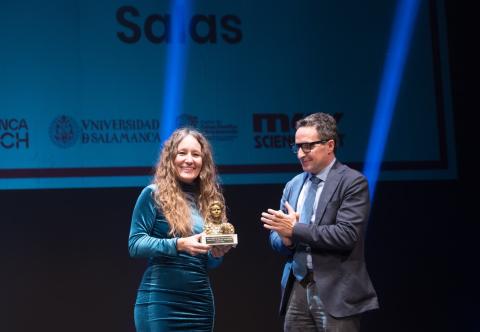A team lead by CENIEH studies the Cueva de los Torrejones, a site in the province of Guadalajara, using new techniques that have allowed the changes in the Peninsula's inland ecosystems at three moments in prehistory to be analyzed

Adrián Pablos and Nohemi Sala, researchers at the Centro Nacional de Investigación sobre la Evolución Humana (CENIEH), lead the team that has recently published two papers in the journals Quaternary Science Reviews and Radiocarbon on the Cueva de los Torrejones, a classic site in the locality of Tamajón (Guadalajara), that furnish new data on the Quaternary ecosystems of the peninsular interior, a region with a meager archaeo-paleontological record.
The results obtained have enabled at least three chronologies recorded at the site to be detected. The oldest episode is from the period between 70,000 and 90,000 years ago (between the so-called Marine Isotope Stages MIS 5 and MIS 4), when the cave was used as a carnivore lair. The conditions inferred during this period point to a mild and moist climate with a rich and varied ecosystem inhabited by hyenas, leopards, rhinoceros and tortoises, as well as other vertebrates.
The second episode is represented by a faunal association dated at 30,000 years old, and is indicative of cooler and drier environmental conditions compatible with the cooling previously detected in the central Peninsula in Marine Isotope Stage MIS 3.
The last episode is the Chalcolithic, dated approximately to 4500 to 5000 years ago, a period when humans used the cavity on many occasions to accumulate the bodies of their dead. Analysis of the mitochondrial DNA in a human ankle bone dated directly to 5000 years old has allowed it to be assigned to haplogroup K, a group originating in the Near East which moved into western Europe in the Neolithic.
.

The information provided by paleontological sites is valuable for deciphering the climatic and environmental conditions represented at each site or stratum, rather like a snapshot of each moment preserved. “The more photos you have, the finer the chronological resolution that may be possible, and therefore the greater your ability to reconstruct the significant changes in the climatic and ecological conditions over time, and to see how these may have influenced the species inhabiting those ecosystems, including humans”, explains Sala.
Since 2017
The team led by the CENIEH researchers resumed excavation work in 2017 at this cave discovered in the 1990s, with financing from the Junta de Comunidades de Castilla la Mancha, the CENIEH itself and ERC MULTIPALEOIBERIA , and the collaboration of GE Abismo and the Ayuntamiento de Tamajón.
“The new analytic methodologies of excavation and study of remains permit us to pin down the interpretations yielded, and over the next few years we will continue excavating sites around Tamajón so we can fill in the blanks in the archaeo-paleontological record of this inhospitable region”, declares Sala.
The researchers on this team are attached to Spanish institutions: Universidad Complutense de Madrid, Centro Mixto UCM-ISCIII de Evolución y Comportamiento Humanos; Institut Català de Paleoecologia Humana i Evolució Social (IPHES); Universidad del País Vasco/Euskal Herriko Unibertsitatea (UPV/EHU); Universidad de Oviedo; Sociedad de Ciencias Aranzadi; Universidad de Alcalá; Universidad de Zaragoza; Aragosaurus; IUCa and Instituto Geológico y Minero de España (IGME), as well as German ones: Max Planck Institute and University of Tübingen.





